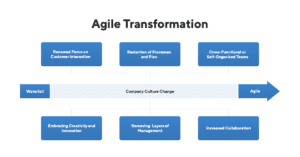What is Agile Transformation?
Agile transformation is the process of transitioning an entire organization to a nimble, reactive approach based on agile principles.
Understanding agile transformation begins with understanding what it is not: adopting agile software development methodologies.
While any organization undergoing this transformation is likely to also embrace agile, Scrum, Lean, etc., agile transformation is a much larger endeavor than just changing how software gets built.
Instead, this is a complete transformation of the entire organization and extends far beyond product development. The goal is to breathe new life into the organization by creating an environment that embraces creativity and innovation, empowering employees, and reducing unnecessary layers of management.
The end result may include cross-functional or self-organized teams, a renewed focus on customer satisfaction, a reduction in processes and plans in favor of action, and increased levels of internal communication and information sharing.

What does an Agile Transformation Process Entail?
Like all major undertakings, the agile transformation process begins by designating a leadership team, setting goals, and creating a roadmap. Periodic check-ins of progress made against the roadmap and necessary adjustments are essential to keeping the project on track while still being realistic.
A communication plan should accompany the tactical one, to ensure the entire organization understands the objectives and is continually notified of progress against the goals. As this is such a large endeavor, smaller pilots are usually conducted before an organization-wide rollout.
Assembling cross-functional teams is key, creating groups of 5-10 individuals that have enough expertise and talent between them to take on projects from inception to completion. These self-contained units are able to eliminate handoffs and the inevitable problems that arise during those transitions.
Project assignment also shifts from the individual to the team approach. The team as a whole is evaluated for different projects and specific staff is not cherry-picked for a particular engagement.
To make this happen, waterfall development, organizational silos, and bureaucracy must be curtailed to provide an environment that embraces agile transformation. While some of this may be done in one fell swoop, much of this is ongoing, continual assessment and improvements to continue fostering an agile-friendly workplace. This may even include changes to office layouts to colocate team members in the same physical space.
Employees will also need continual coaching and professional development to make the most of an organization’s agile transformation. These are new concepts and best practices for most staff, so investments in training and mentoring are key to company-wide buy-in. This includes empowering employees to work independently and solve problems themselves while also educating managers on how to evaluate and reward staff in this new paradigm.
New processes must be developed, and new tools and solutions may be acquired to facilitate these new workflows. Each will need ownership, training, and dissemination throughout the organization.

What are some common challenges in agile transformation?
Successfully completing an agile transformation is easier said than done; it is a significant paradigm shift for those involved and maybe unsettling or upsetting for those more comfortable in a traditional environment. Power structures are upended and turf battles may ensue.
Agile transformation is a lengthy process—often spanning years—and sometimes does not survive long enough for full implementation. Without full executive buy-in and consistent leadership, these efforts may fade before the benefits are fully realized and the transformation is complete.
Changes in leadership can also derail a transformation or undo some of what was enacted, as new leadership may not believe in its merits, agree with the decentralized structure or want to devote the required time and resources. Lacking a continuing commitment and urgency to the transformation, there’s a high likelihood of these efforts dying on the vine.
Communicating the value of agile transformation to every employee is an additional challenge since the transformation spans far beyond product development. Customer-centricity may not be as openly embraced by Accounts Receivable as it is by Customer Service.
Conclusion
Agile transformation enables organizations to be more reactive, do more with less, and better serve the interests of their customers. To do it well, an agile transformation requires significant support, resources, and time, not to mention the commitment to stick it out when things get bumpy.
A successful agile transformation can revolutionize how a company manages projects, addresses customer needs, and grows its business, which is why some organizations are willing to take on the associated effort required to bring it to fruition.